World Oceans Day was established in 2002 by the United Nations to protect and celebrate Oceans. We pulled together some oceans facts that demonstrate why saving our oceans is crucial to not only personal and fiscal health but the health of the planet.
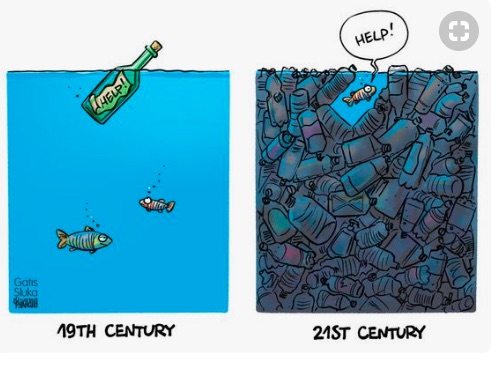
- 70% of the world is covered by Oceans.
- Historically, there are four named oceans: the Atlantic, Pacific, Indian, and Arctic. However, most countries – including the United States – now recognize the Southern (Antarctic) as the fifth ocean. The Pacific, Atlantic, and Indian are known as the three major oceans. (NOAA)
- The Southern Ocean is the ‘newest’ named ocean. It is recognized by the U.S. Board on Geographic Names as the body of water extending from the coast of Antarctica to the line of latitude at 60 degrees South. The boundaries of this ocean were proposed to the International Hydrographic Organization in 2000. However, not all countries agree on the proposed boundaries, so this has yet to be ratified by members of the IHO. The U.S. is a member of the IHO, represented by the NOS Office of Coast Survey.
- The Arctic Ocean is almost completely covered in sea ice during the winter.
- Only 5% of the world’s Oceans have been explored.
- Deep Sea refers to the part of the ocean where light does not penetrate. This is about 300 feet under the surface.
- The surface of the ocean absorbs over half the heat reaching the Earth from the sun. By distributing this heat around the world, ocean currents – which flow for thousands of kilometres, both at the surface and far below – are extremely important in determining the climate of the world’s continents. (Source)
- 70% of the oxygen we breathe is produced by the oceans.
- That oxygen is produced by seaweed and phytoplankton that live in the ocean.
- The largest Ocean is the Pacific Ocean, which covers about 30% of the worlds surface.
- The Pacific Ocean’s name means ‘Peaceful Sea”. The latin name is Tepre Pacificum,
- Over 25, 000 islands are located in the Pacific Ocean Alone
- The Pacific Ring of Fire, is a large number of active volcanoes which surround the Pacific Ocean.
- 90%t of all volcanic activity on Earth occurs in the ocean.
- 15 + Tsunamis have occurred since 2000. These are caused by underwater volcanic activity, earthquakes, and landslides.
- Cost of Japan’s 2011 Tōhoku earthquake and tsunami was $397 Billion
- The Atlantic Ocean, it covers over 21% of the Earth’s surface and is the 2nd largest ocean.
- Atlantic Ocean’s name refers to Atlas of Greek mythology.
- The mysterious Bermuda Triangle is located in the Atlantic Ocean.
- In 1932 Amelia Earhart flew over the Atlantic Ocean to become the first woman to do so.
- The Indian Ocean, covers around 14% of the Earth’s surface and is the 3rd largest ocean.
- The Indian Ocean is the warmest. Its surface water can sometimes reach past is 86 degrees Fahrenheit.
- The Mid-Oceanic Ridge is the longest mountain range in the world and is found in the ocean. It is over 35,000 miles long and stretches from the Atlantic to the Pacific Ocean.
- 23% of the Earth’s surface is covered by The Mid-Oceanic Mountain Ridge.
- Mauna Kea is the highest mountain on the ocean. From the ocean floor, it is about 33,400 feet high with 13,000 feet of its total height above the water.
- The Great Barrier Reef is the worlds largest structure and can be seen from the moon. Measures around 2,600km or 1615 miles.
- The deepest area we know about is the Mariana Trench It has a deepest point of around is 36000 feet.
- The deepest dive by a human submersible vehicle was done in the Mariana Trench in 1960 by Jacques Piccard and Don Walsh.
- Oceans have an average depth of two and a half miles (13200 ft)
- Rivers and Lakes are also in the ocean. This occurs when salty water and hydrogen sulfide mix to form a dense brine that is heavier than regular seawater.
- There are also underwater hot springs, chimneys that spew sulfuric acid in the oceans.
- Kelp Forests can go from the ocean bottom to the surface. Kelp can grow up to 2 feet per day.
- The exact number of marine wildlife is not known. There are estimates the numbers could be in the millions.
- 94% of all life forms on Earth are aquatic.
- Ocean Tides are caused by the Moon and the Sun’s gravity pulls on the ocean water when the Earth Rotates caused by the Earth rotating while the Moon and Sun’s gravitational pull acts on ocean water.
- 20 Million Tons of gold is estimated that the world’s oceans and seas contain.
- The ocean is also mined for minerals (salt, sand, gravel, and some manganese, copper, nickel, iron, and cobalt can be found in the deep sea) and drilled for crude oil.
- Oceans are the worlds largest museums. relics, artifacts, ruins, and shipwrecks exist and lost cities exist under the ocean.
- The lost city of Thonis/Heracleion off the coast of Egypt was discovered in 2000.

Lion City was named due to Five Lion Mountain loomed large behind it. The city, also known as Shi Cheng, has been buried beneath the water for 53 years in China - 50%of United States’ legal jurisdiction territory are under the ocean.
- Sound travels fastest and further in the ocean at an underwater speed of 1435m per second. That is almost 5x faster than in air.
- Many ocean animals communicate, navigate and forage food by sound. human-generated ocean noise pollution is altering the underwater acoustic landscape, harming—and even killing—marine species worldwide.
- Negative responses to anthropogenic noise have been demonstrated in at least 27 species of marine mammals in scientific studies (Source)
- Oceans are worth at least $24 trillion, according to a new WWF report Reviving the Ocean Economy
- 90% of trade between countries is carried by ships.
- 10,000 Shipping Containers Lost At Sea Each Year. (one report) another states 1390 shipping containers are lost at sea every year. (2017)
- 50% (about) of the world’s lives in a coastal zone
- The ocean is #1 source of protein for more than a billion people.
- 140 million jobs are provided by the ocean.
- Ocean-based businesses, from fishing to medical to tourism contribute more than $500 billion to the world’s economy.
- Overfishing is one of the biggest threats to the health of seas.
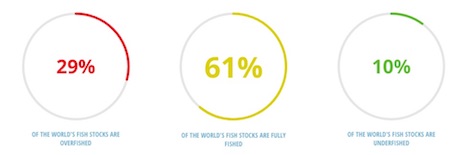
Image: World Wildlife Fund - If all the glaciers, icebergs, and ices sheets meltes in an instant, sea levels would rise 262 feet. This would fully submerge most coastal cities in the world.
- 20-25% of dredging waste ends in oceans. This includes toxic chemicals which are a death sentence for ocean life and humans.
- It is estimated that air pollution is responsible for at least one-third of toxic contaminants that are dumped on a yearly basis onto oceans and other bodies of water.
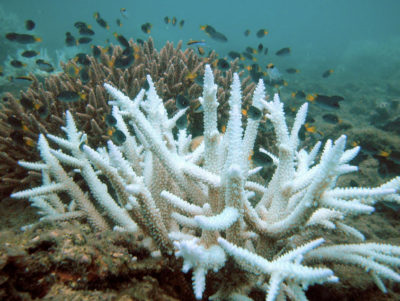
Coral bleaching: Image Creative Commons: Climate Protection - 75% of the world’s coral reefs are at risk from local and global stresses. About a quarter of them have already been damaged beyond repair.
- 90% of coral reefs will be in danger by 2030, and nearly all of them by 2050 if human continue doing what we do now. (State of the Planet)
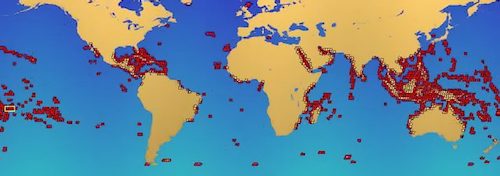
Coral Reef Locations - A study of 159 reefs in the Pacific found that plastic pollution is killing coral. When coral reefs come into contact with plastic waste, the incidence of disease rises 20x.
- The Great Pacific Garbage patch, a floating plastic garbage island was discovered in 1997 by sailing Captain Charles Moore by accident.
- The North Pacific Garbage Patch is located about 1,000 miles northeast of Hawaii and about 1,000 miles off the coast of California.
- (5 ) Ocean Plastic gyres: the North Atlantic, South Atlantic, North Pacific, South Pacific, and Indian Ocean gyres.
- 6x as much plastic as plankton are in the ocean garbage patches. Marine animals eat plankton and humans eat marine animals.
- 2011: Scientists from UC San Diego found plastic in 9.2% of the fish they studied in over 1700 miles of the Pacific Garbage Patch. Based on this 2011 study, researchers estimate that the fish in the North Pacific Ocean consume plastic at a rate of roughly 12,000 to 24,000 tons per year.
- The Oceans absorb as much as a quarter of all man-made carbon emissions, which changes the pH of surface waters and leads to acidification.. leading to climate change.
- 270,000 tons of plastic are floating on the surface of the ocean (estimated)
- 80 percent of marine litter is from the land.
- Plastic is the most common type of marine litter that is found in the ocean.
- Over 1 million seabirds are killed by ocean pollution each year.
- 693 species had been documented as having encountered plastic debris, with nearly 400 involving entanglement and ingestion. (One Green Planet)
- Over 300,000 dolphins and porpoises die each year just by becoming entangled in ghost nets or discarded fishing nets
- Over 100,000 sea mammals are killed in the ocean by pollution each year.
- Over 50% of the world turtles have eaten plastic.
- Over 700 marine species might go extinct due to plastic pollution.
- 100 million sharks+ are killed every year around the world. That is a number that means they may not be able to recover.
- 12 humans were killed worldwide by sharks in 2011, according to National Geographic.
- Oil is the number one source of deterioration to the ocean. Most of the oil pollution is due to oil drainage from land.
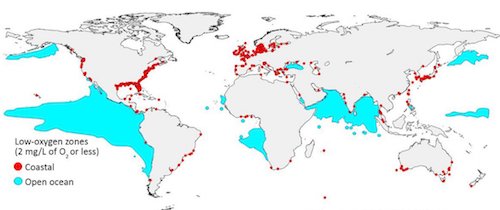
Image Image: Science Alert
- 706 million gallons of waste oil in the ocean each year, offshore drilling operations contribute about 2.1 percent, and transportation accidents (both ships and tankers) account for another 5.2 percent (Water Encyclopedia)
- The 2015 El Capitan State Beach spill in Goleta, CA, with 2,500 barrels of oil from a pipeline cost $62 million to clean up 100 miles of coast line.
- Off Santa Barbara, California, about 20 to 25 tons of oil flows from seafloor cracks—making it one of the world’s largest oil seeps.
- 777,000 tons of water tainted with tritium, a byproduct of the nuclear process that is notoriously difficult to filter out of water, will be dumped into the Pacific Ocean as part of a multibillion-dollar recovery effort following the Fukushima nuclear disaster in 2011. (Newsweek)
- 405+ dead zones are identified in the world. That is up from 49 in the 1960.Fertilizer runoff and fossil-fuel use lead to massive areas in the ocean with scant or no oxygen, killing large swaths of sea life and causing hundreds of millions of dollars in damage
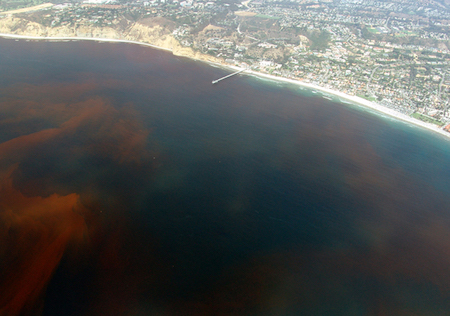
Image: Wikipedia Dead Zone Ecology. Dead zones are often caused by the decay of algae during algal blooms, like this one off the coast of La Jolla, San Diego, California. - The worlds largest dead zone is in the Baltic Sea, whose bottom waters now lack oxygen year-round.
- The five biggest threats to the ocean: Overfishing, illegal fishing, Coastal pollution, Habitat destruction, Warming, Acidification, Mining.
In conclusion, as human continue to destroy the oceans… nobody wins.
Resources
- Coral Reefs and Medicine
- 20 Surprising Facts About Ocean Pollution
- How Oil Spills effect Marine Life
- State of the Planet Earth Institute: Coral Reefs
- Types of Ocean Pollution
- Marine Bio: Ocean Resources
- The Cost of Oil Spills
- The Cities That Will Drown From Global Warming.
- Surging Seas: Sea Level Rise Analysis by Climate Central
- Rising Sea Level May Trigger Groundwater Floods
- Sea Level Rise ‘Locking In’ Quickly, Cities Threatened
- U.S. Airports Face Increasing Threat From Rising Seas
